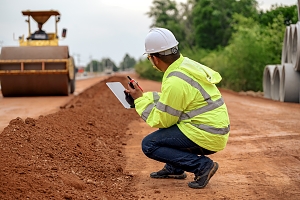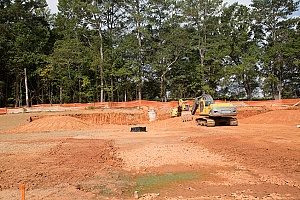Understanding the Importance of Quality Dirt for Your Project
Most people think dirt is just dirt. However, construction workers and gardeners know that the quality and composition of dirt make a huge difference in how it can be used. There are two main types of dirt used in landscaping projects: fill dirt and topsoil. Knowing the differences between these types can help you choose the best option for your project. Sometimes, you might even need to combine both to get the desired results. Once you know what kind of dirt you need, make sure you’re getting clean fill dirt for your project.
Watch the Video Version of This Blog
For a quick and engaging overview, check out our video on ‘What Is Clean Fill Dirt?’
What is Fill Dirt?
Fill dirt is used to fill holes, level low areas, or increase ground elevation on construction sites. It comes from the subsoil, which is found about 12 inches below the surface. This dirt is made of partially broken-down soil containing clay, sand, silt, stones, and other materials from the source ground. If the fill dirt comes from an old farm field or woodland, it might contain organic material, but the best fill dirt is mostly inorganic. Its inorganic qualities make it ideal for filling because it doesn’t decompose and settle like organic soils.
Fill dirt is usually cheaper than topsoil or other types of dirt needed for landscaping plants. For example, you need organic-rich dirt for gardening, depending on what you want to grow. However, when building a home or roadbed, you can’t use topsoil or garden soil because the organic materials will decompose, causing the surface to sink. This type of soil also erodes quickly and won’t support building structures. For construction projects, you need rockier, heavier, inorganic fill dirt.
Where Does Fill Dirt Come From?
Fill dirt is often used to change the grade or elevation of a property to make it more suitable for its intended use. It’s known as subsoil because it’s taken from below the topsoil, usually about six inches deep. This depth is intentional because it doesn’t contain organic matter, which breaks down over time. While organic matter enriches the soil for plants, it also makes topsoil unstable as it decomposes. This instability is why you can’t use topsoil for construction. The lack of organic matter in fill dirt makes it unsuitable for gardening but perfect for construction.
What Makes Fill Dirt “Clean”?
“Clean” fill dirt doesn’t contain toxins, organic matter, or large debris. If these elements are present, they can compromise the stability of your fill dirt and ruin your project. Always ensure you order fill dirt from a certified Virginia fill dirt contractor who screens their dirt. Clean fill dirt must be processed to remove large debris, tested for chemicals and toxins, and screened to ensure it contains no organic matter. Because of these processes, fill dirt must meet certain local regulations before it can be used. So, when searching for fill dirt, find a local company that provides certified, clean fill dirt.
Uses for Clean Fill Dirt
Clean fill dirt is mostly used for construction projects. This includes land grading, highway maintenance, creating foundations, and excavation. It’s also used as backfill and in landscaping projects that require elevation changes, such as adding or removing a swimming pool or creating a waterfall. Although the dirt will likely be hidden once the project is completed, it plays a major role in the structure and stability of the final product. Since fill dirt is crucial to the success of your project, make sure you’re only working with clean fill dirt.
Clean Fill Dirt for Land Grading and Landscaping
Sometimes, your yard might have dips or low points that are problematic or unattractive. You may want to fill them in for aesthetic reasons or practical purposes, like preventing flooding after rain. Low points can also make mowing your lawn challenging. The solution is land grading, which levels out the land. Land grading is common in construction because it makes the land more suitable for building. To grade your land, simply fill the low points with clean fill dirt to make the area level.
If your landscape is too flat and boring, fill dirt can also help you add interest and dimension. You can use it to create hilly areas or multi-level terraces.
Clean Fill Dirt for a Strong Foundation
A strong foundation is the most important part of any construction project. Fill dirt is ideal for creating foundations because it’s made of clay, sand, and rock, which won’t move or shift over time. This ensures your project will have a stable foundation that lasts. Fill dirt is great for building the foundations of houses, driveways, and roads. It’s also commonly used for highway maintenance, providing long-lasting support.
Clean Fill Dirt to Support Topsoil
You can use fill dirt and topsoil together to level out low areas in your yard. Start by filling the low spot with fill dirt, then lay topsoil over it so grass or plants can grow. Another use is creating a terrace in your backyard. Once the terrace is built with fill dirt, add topsoil to create a garden. Using both types of dirt together helps you shape your perfect outdoor space.
Other Types of Fill
When planning a construction project, choosing the right type of dirt is important. Here are some commonly used types of fill:
Fill Sand: Fill sand and fill dirt may seem similar, but they serve different purposes. Fill sand is made of fine rock particles that have eroded over time. It’s great for improving drainage in wet areas, around septic tanks, and ponds, where water flow is important. However, sand tends to shift easily, while fill dirt stays stable. For planting areas, fill sand with more than 50% sand works well. After laying the sand, top it with a few inches of topsoil to support plant growth. In summary, fill dirt is best for projects needing stability, while fill sand is better for areas exposed to water and moisture.
Topsoil: Topsoil is organic and contains nutrients that support grass and plants. If you need to fill shallow low spots in your landscaping, topsoil works well. It contains few rocks or debris and is easy to spread and level with a rake.
Rock Fill: Rock fill contains large rocks, often bigger than a football, used to fill deep openings. These rocks can also be used for landscaping. To grow grass or plants, you’ll need to top it with clean topsoil, followed by compost, mulch, or manure.
Contact a Reputable Dirt Supplier
To ensure your project’s success, make sure you’re getting the correct type of fill. Consult with a reputable dirt supplier. A knowledgeable provider can discuss your project needs, help you comply with any laws, and deliver quality dirt. Fill dirt can shape your yard, while topsoil will support healthy plants. Contact a Virginia fill dirt contractor for more information and to schedule your fill dirt or topsoil delivery. You can also use the Dirt Connections Portal to see available materials.
Transform Your Project with Quality Fill Dirt
Don’t leave your project’s success to chance. Whether you need clean fill dirt for construction, landscaping, or land grading, Dirt Connections is your trusted partner in Maryland, Virginia, and Washington, DC. Our clean fill dirt ensures stability, safety, and long-lasting results for your project.
Contact us today to discuss your specific needs and schedule a prompt delivery of top-quality dirt that meets your exact requirements. Ready to get started? Contact Dirt Connections. Let us help you build a strong foundation for your next project. Use this link for a free online quote for material delivery. Let us help you build a strong foundation for your next project—reach out now and see the difference our expertise and commitment to quality can make.








































